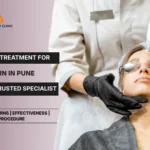What is Hyperpigmentation? Causes, Symptoms, and Types Explained
Home | Blogs | What is Hyperpigmentation? Causes, Symptoms, and Types Explained


Do you have skin patches that appear darker than the surrounding skin?
Then, it is likely to be hyperpigmentation.
Hyperpigmentation is a condition that causes patches of skin to become darker than the surrounding skin due to excess melanin production.
However, what causes hyperpigmentation, what are its symptoms, and what are its types?
Learn it from a reliable and seasoned dermatologist in Pune through this post.
Key Topics Discussed in This Article
Hyperpigmentation Causes
Hyperpigmentation is a common condition from which millions worldwide suffer.
The condition features skin patches darker than the surrounding skin due to the overproduction of melanin, the pigment that gives skin its color.
So, what causes the skin to overproduce melanin and suffer from hyperpigmentation? Let’s look at some common causes.
- Sun Exposure: When the skin is exposed to UV rays for a long time, it produces more melanin as a protective reaction causing sunspots or age spots.
- Genetics: Another common reason for hyperpigmentation is genetic predisposition. Thus, people with a genetic predisposition to hyperpigmentation can develop the latter.
- Hormonal Changes: Melasma, a type of hyperpigmentation, can be the reaction of hormonal changes during pregnancy or due to the use of oral contraceptives.
- Inflammation or Injury: Skin trauma like burns, cuts, acne, or psoriasis can lead to post-inflammatory hyperpigmentation (PIH).
- Exposure to Chemicals: The skin’s contact with certain chemicals or allergens can result in localized hyperpigmentation.
- Underlying Medical Conditions: Certain conditions like Addison’s disease or hemochromatosis can darken the skin, resulting in hyperpigmentation.
Hyperpigmentation Symptoms
The symptoms of hyperpigmentation differ with the type of condition an individual is suffering from. However, some common symptoms of hyperpigmentation include,
- Dark Spots or Patches: Areas of skin become darker than the surrounding skin, causing dark spots or patches, commonly seen on hands, face, shoulders, or other regions often exposed to sunlight.
- Uneven Skin Tone: Hyperpigmentation also causes discoloration that may lead to patches of uneven pigmentation on the skin.
- Color Variations: Furthermore, affected regions range from light brown to black, based on the individual’s skin tone and severity.
Types of Hyperpigmentation
Hyperpigmentation affects the skin in various ways, which also form its types. Some common types of hyperpigmentation include the following.
Melasma
Melasma features dark brown skin pigmentation in regions exposed to the sun.
Although melasma can occur on part of the body, it is usually observed on the face.
Besides, melasma is more common in women than in men.
Post-Inflammatory Hyperpigmentation
Also called PIH, it involves dark patches on the skin resulting from hypermelanosis, in turn, caused due to inflammation or injury.
However, usually, PIH fades on its own.
Sunspots
Prolonged sun exposure results in flat dark spots called sunspots, liver spots, or age spots. These are usually harmless and treatable.
Hyperpigmentation Treatment
You can treat hyperpigmentation with various clinical methods, usually available at a comprehensive and experienced skin clinic in Pune. Some include the following.
- Microdermabrasion: Microdermabrasion is a minimally invasive procedure that involves epidermal resurfacing to treat uneven skin tone and texture, sun damage, melasma, acne scars, and photoaging.
- Chemical Peels: Chemical peels involve removing the skin’s top layers by applying a chemical solution to treat the discolored skin.
- Laser Resurfacing: As the name suggests, laser resurfacing involves using a laser to reduce the appearance of scars and pigments, tightening the skin, removing tumors, and making the skin color even.
- Intense Pulsed Light (IPL): IPL also uses laser energy to target pigmented or damaged skin cells and eliminate them. The treatment helps reduce melasma, hyperpigmentation, acne marks, sun damage, and freckles.
- Cryotherapy: This procedure involves administering liquid nitrogen in a particular spot and freezing for some seconds. It eliminates the pigmented cells via freezing. As the skin heals, it lightens.
Want to Get Rid of Hyperpigmentation?
With years of experience and a team of skin specialists, Eva Pimples, Skin and Hair Clinic steps in as a trustworthy dermatologist in Pune.
Our personalized hyperpigmentation treatment involves diagnosing the case thoroughly and providing well-suited treatment options for optimal outcomes.
The hundreds of patients with varying types and levels of hyperpigmentation we’ve treated, say it all about our position as the best skin specialist in Pune.
Call us at +91 788 799 1919 to schedule an appointment.
Frequently Asked Questions
How do I clear my hyperpigmentation?
Hyperpigmentation is treatable. Although the treatment option varies with the individual, some popular clinical options include laser therapies, chemical peels, cryotherapy, and prescription medicines. Your dermatologist will be the best person to determine which hyperpigmentation treatment options suit you.
How to prevent hyperpigmentation?
Preventing hyperpigmentation involves safeguarding from various trigger factors that darken the skin. While specific preventive measures may vary, some common ones include the following.
- Using sunscreen with SPF 30 or higher
- Avoiding stepping out in the sun during the peak sunshine hours
- Preventing skin trauma by picking, squeezing, or scratching the skin
- Regularly exfoliating the skin
- Following a regular and personalized skincare routine
- Maintaining a healthy and suitable diet
Can rice water help remove pigmentation?
Rice water can help lighten dark spots on the face and brighten the skin tone, thus enhancing the appearance of hyperpigmentation.


